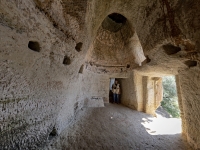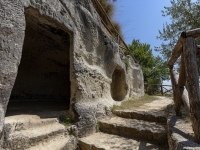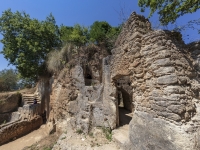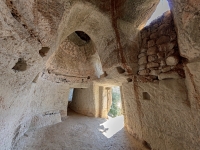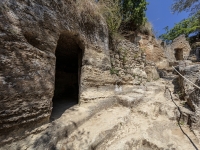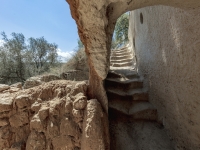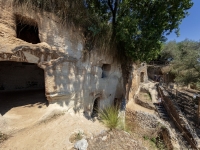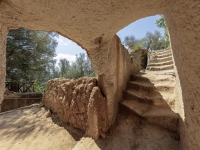Reisen
The rock caves of Zungri Calabria Italy
Zungri Region Calabria of Italy
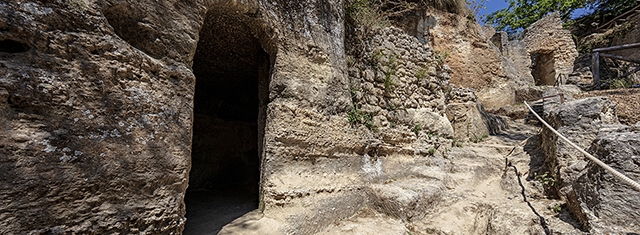
The rock caves of Zungri (Quelle: Roberto Magni by Foto ReD Photographic Agency)
GDN -
During your visit to the Calabria region do not miss the opportunity to visit the Zungri Caves, a unique rock settlement in Calabria, a magical place that will immerse you in another civilization, made up of caves carved into the sandstone.
Zungri is located in Italy on Mount Poro in Calabria a few kilometers away from the nearby tourist resorts Capo Vaticano and Tropea. The ancient settlement is nestled in a deep valley overlooking the Costa degli Dei, one of the most beautiful coasts of Calabria. Zungri and consists of the rock village of "Sbariati", located in the locality of "Fossi". This ancient village is a unique place that testifies to the refined architectural knowledge of the monks. They were born and spread to the east (Basilio lived between 330 and 379), but in the eighth century AD. they are forced to flee due to the persecutions of the so-called iconoclastic struggle (the prohibition of reproducing sacred images).
They mainly take refuge in southern Italy: in Calabria in the Monte Poro area, in Puglia and in Sicily. Before entering the Rupestrian part you can visit the Museum of Rural Life where about a thousand artifacts are kept, testimony of a rural world that unfortunately has almost disappeared today. This Museum is not a simple collection of objects but is the reinterpretation of a culture in respect and exaltation of the human, historical and social roots of Zungri.
The Zungri Caves are immersed in a magical and fascinating natural environment. The itinerary to visit the Rock Settlement starts from the Museum and descends through a path that leads to the archaeological site. This path proceeds "back in time", in fact the first buildings you see are also the most recent ones, as you descend you enter the oldest part of the settlement, up to the areas not yet accessible to the public which hide many other secrets. The caves overlook the deep valley carved out by the Malopera stream, whose banks are flanked by arable land, still accessible today, where the inhabitants of the caves used to carry out agricultural activities.
The Rock Settlement, also known as "Caves" has an area of about 3,000 square meters and studies on its origin are still in progress. The most accredited hypothesis would have been: a colony founded by oriental populations, or a productive outpost / deposit of the nearby Kastron di Mesiano.
This Rupestrian village has many caves, these were used as homes or warehouses for the conservation of grain. the oldest was built on four levels and inside you can see a rock drawing of a fish, it was built and modified over time, the oldest traces of the site seem to date back to the VIII-XII century.
It consists of dozens of rock units partly dug into the rock with single and two-celled environments, some even with several floors and partly built, for residential use, for the shelter of domestic animals, for the production of wine and lime, for the grain storage. The village forms the framework of a complete urban structure: narrow lanes, steps and a water supply system. The circular or square housing cells have a domed roof to allow ventilation. Each niche is characterized by recesses in the walls to arrange beds and furnishings. This archaeological site is very interesting and shows us by making us understand the socio-economic organization of these ancient populations.
The interior spaces of the caves vary in size, with a privileged use of the rectangular plan, compared to the ovoid one. The rooms are both single-celled and made up of several rooms, spread over one or two levels. The higher floors could be accessed by means of stairs, made of wood or carved out of stone. The interiors of the caves allow you to imagine the distribution of space and lifestyle of the rocks. Along the walls of some cavities, in fact, there are visible niches or recesses dug into the rocky bank, where beds, shelves or pantries were probably placed. These are very useful elements that help to better understand the functional use of spaces and the habits of living in the cave. The regularity of the vertical surfaces of the facades are interrupted by the openings of the doors and windows that offer spectacular alternations of solids and voids.
The entrances to the cavities have been obtained by digging quadrangular or arched openings and, in some cases, the inspiration of man has given life to real decorations obtained by carving in the stone motifs engraved in imitation of stone portals, well finished in the jambs and in the holes intended for housing metal or wooden elements.
In the rupestrian settlement of Zungri, the community that inhabited it has differentiated the spaces, separating the living spaces from the areas intended for productive and agro-pastoral activities, as in the case of the small millstone, located at the beginning of the town, or of the "limestone" almost entirely carved out of the rock, used as a factory for the production of lime. Another aspect, of fundamental importance for the daily life of the settlement, is the complex system of exploitation of water resources. The territory of Zungri has always been rich in springs and freshwater veins and the rocks have wisely exploited this natural element by creating useful connections between pools, wells and channels, made inside or outside the caves with excavation of the rocky bank.
There is also a Museum of peasant and cave civilization within the village. All the necessary information on planning a visit on
Via Indipendenza 89867 Zungri (Vibo Valentia Calabria Italy)
www.grottezungri.it
info@grottezungri.it
weitere Informationen: https://www.redmagazine.red
Für den Artikel ist der Verfasser verantwortlich, dem auch das Urheberrecht obliegt. Redaktionelle Inhalte von GDN können auf anderen Webseiten zitiert werden, wenn das Zitat maximal 5% des Gesamt-Textes ausmacht, als solches gekennzeichnet ist und die Quelle benannt (verlinkt) wird.

